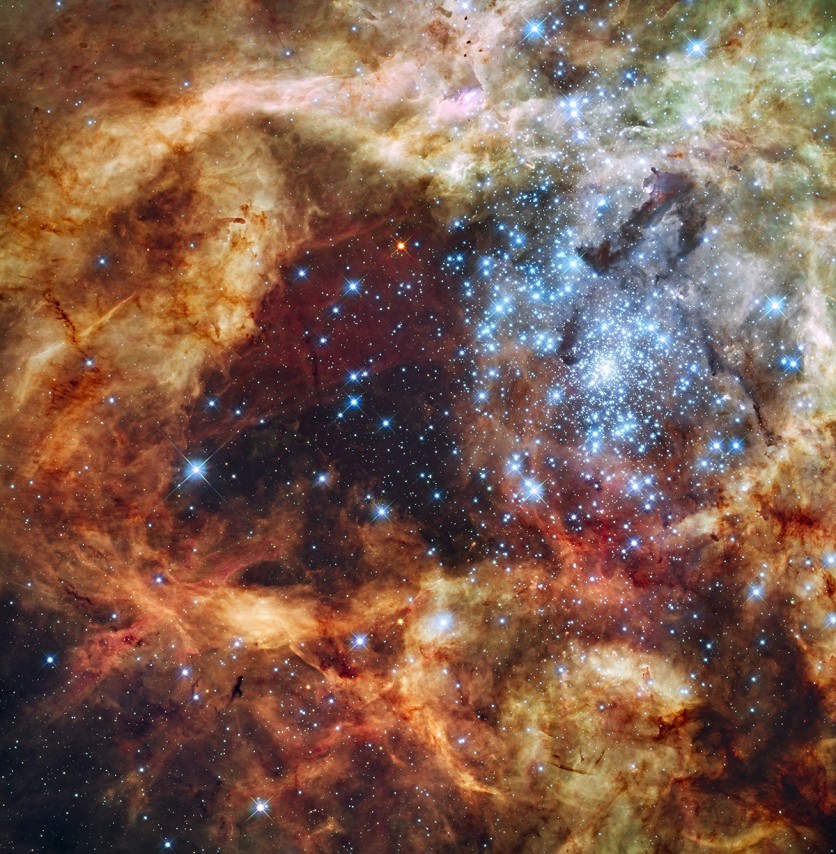NASA's Hubble Space Telescope once captured the biggest star ever found in the galaxy, which was previously thought to be 250 to 320 times more massive than the Sun. But a new study claims that the estimate may be different.
The largest known star has been captured in some of its finest photographs yet, suggesting that the upper limit of a sun's mass is likely to be far lower than previously thought.

Massive Star In The Tarantula Nebula
As reported first by ScienceAlert, the mass of the star R136a1 was first estimated to be between 250 and 320 times that of the Sun. According to the latest estimate, its mass ranges from 150 to 230 times larger than the Sun.
The star is still a massive record holder with this new estimate of almost 200 solar masses, but its decreased mass revision may have broader impacts.
The investigation was carried out as a part of the R136 cluster understanding project. It is located in the Tarantula Nebula, a region of the Milky Way's Large Magellanic Cloud where star formation is active.
Several of the most massive stars are discovered in this cluster, albeit their original masses have since been revised lower. These masses serve as crucial anchor points for the upper mass function of massive stars. Therefore the work may indicate that our previous stellar upper mass limitations are incorrect.
According to Gemini Observatory astrophysicist and astronomer Venu Kalari's findings, the most massive star currently known is not as huge as previously believed, and the upper limit on stellar masses may be lower.
Calculations and modeling indicate that there must be a maximum star mass, even though we are unsure of what it is, according to ScienceAlert.
Read also : NASA's Hubble Space Telescope Captures 'Orion Nebula's Dreamy Cloudscape' With Over 500 Exposures!
The Eddington Limit
It is widely acknowledged that material from the star's outer layers must be expelled when the gravitational pressure inside the star exceeds the pressure outside at a location known as the Eddington limit.
Earlier studies at 150 solar masses firmly established the Eddington limit. Brand-new information on the R136 stars was then discovered, including a large number of stars with noticeably greater masses.
These young, extremely hot, and enormous stars violated the Eddington limit and stellar formation theories. Later studies discovered that superhot stars in the R136 can develop by star mergers, but the Eddington limit problem remains unsolved.
Kalari and his team wanted to draw new insights from this matter. Hence, they focused on obtaining fresh and crisper photos of the cluster and R136a1.
As a result, the team calculated the new masses of R136a1 and two additional big stars in the cluster, R136a2, and R136a3, which were reduced from 195-211 and 180-181 solar masses, respectively, to 151 and 155 solar masses.
The researchers caution against concluding this discovery because it was obtained by straining the Zorro instrument on the Gemini South telescope.
The following step would be to verify the conclusions, possibly by using and comparing data from another instrument.
Related Article : NASA's Hubble Space Telescope Spots A Red Supergiant Star Recovering From A Violent Explosion
This article is owned by Tech Times
Written by Joaquin Victor Tacla
ⓒ 2025 TECHTIMES.com All rights reserved. Do not reproduce without permission.




